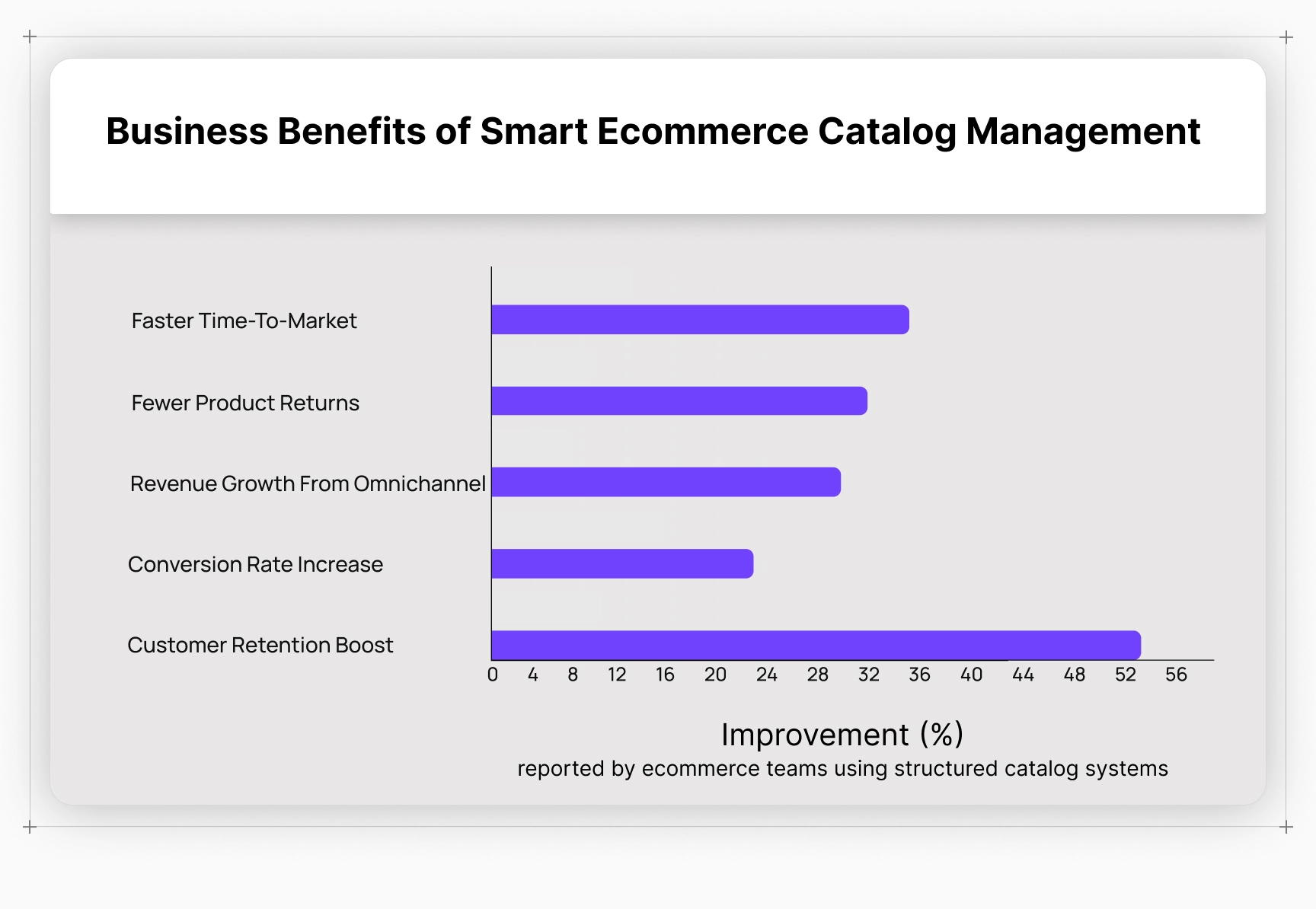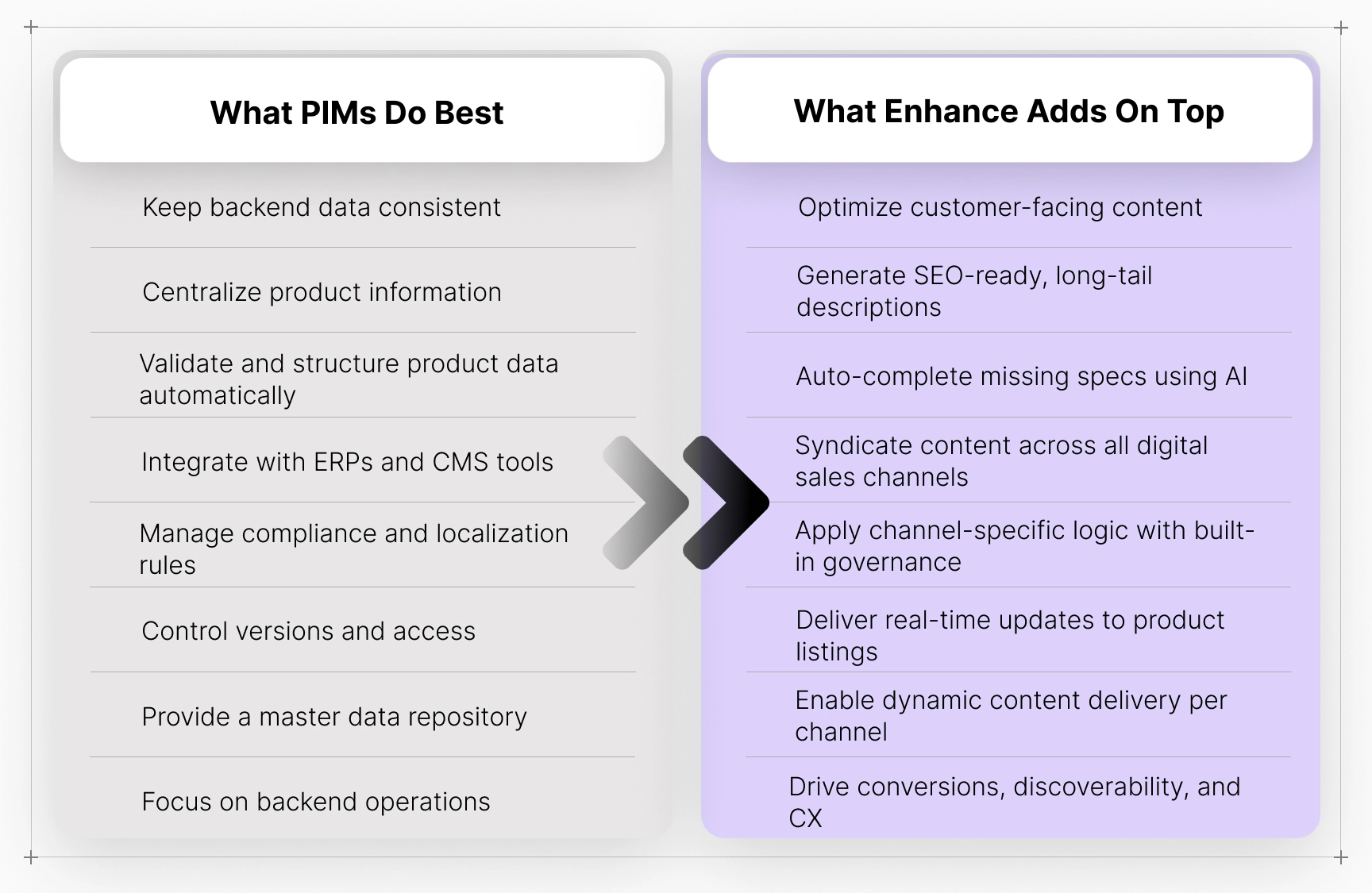Key Takeaways





Key Takeaways




Every search result.
Every recommendation.
Every product page.
They all start in the same place: the product catalog.
And a product catalog is only as strong as the structure guiding it.
Because structure drives speed and speed powers everything downstream.
If your catalog can’t move fast, nothing else can.
Too many systems still treat it like static storage.
But modern catalogs need to move with the business, not lag behind it.
The product catalog holds the logic, structure, and content that every part of your ecommerce operation depends on. It’s where product data turns into customer experience and business performance.
When it runs smoothly, customer experiences feel effortless.
When it doesn’t, friction spreads across online stores, listings, and operations.
And while storefronts have evolved, most catalog management systems haven’t.
Modern ecommerce catalog management means more than uploading SKUs and assigning product attributes. It’s about scale, speed, and consistency across multiple sales channels. It demands structured, real-time product data. Data that stays fresh for search engines and instantly relevant for buyers.
That’s the new baseline for effective product catalog management.
In the sections ahead, we look at what it really takes to manage product data at scale and what becomes possible when your systems finally catch up to your ambitions.
For years, catalog management flew under the radar.
It used to mean uploading SKUs and hoping the listings looked right.
But ecommerce doesn’t look like it did ten years ago - or even last year!
Ask any ecommerce team what makes or breaks scale, and they’ll likely point to one thing: how product data is managed. And shoppers agree - they’re no longer forgiving when it comes to bad product content:
Today the product catalog is like the nervous system of your store's online catalog.
It feeds site search engines, powers recommendation engines, and syncs across every online store. All while supporting conversational AI tools, localized content, and evolving compliance standards.
This level of complexity means product data can’t sit in spreadsheets or float between disconnected tools. That’s why modern teams are rethinking catalog management as infrastructure. Not a backend task, but a central system.
They build it as a real-time engine connecting product attributes, inventory data, and customer experience across platforms.
One that’s structured for scale.
Synced across touchpoints.
Smart enough to support automation without compromising control.
In 2025, a well managed catalog turns operational hygiene into real growth drivers.
Because when your product catalog is structured like a system, everything else gets easier and faster.
{{form}}
Once your product catalog is structured like a system, the next challenge is scale. But let’s face it -growth doesn’t politely knock.
It pushes every system handling SKUs, specs, and syncs to the limit. This kind of pressure exposes every weak spot in your product data infrastructure and that’s exactly where AI-powered catalog management tools are more than needed.
AI tools don’t replace your catalog management process, they reinforce it. They enable sustainable growth through structured scaling.
This ability to grow fast without losing control is the game changer behind smart, scalable catalog operations.
What does scalable catalog management look like in practice?
Modern catalog management tools are built to do more than organize. They structure your digital catalogs for performance.
Here’s what defines the new standard in catalog management software:
Forget disconnected spreadsheets and endless syncs. The new standard starts with a structured core, connecting inventory data, product attributes, and digital assets through one flexible architecture.
It’s how you go from scattered chaos to clean, scalable catalog logic.
Errors don’t fix themselves, but smart systems come close.
AI-first catalog tools handle validation and fill in missing data where humans would stall. They fill in missing product details, spot inconsistencies, and clean up mismatched data, all in real time.
That means fewer gaps, fewer manual corrections, and fewer lost sales due to preventable errors.
Great product pages start with great descriptions and smart systems know how to deliver them.
Leading ecommerce platforms generate rich, channel-ready product descriptions that rank on search engines and convert on product pages. All with zero extra effort.
Updates shouldn’t be batched. Today’s catalog tools push changes instantly across your online store, online marketplaces, and internal systems with logic that keeps everything aligned.
Because when one product changes, everything else needs to follow - titles, specs, product details, formats, even availability. Smart systems keep every channel in sync and every update on point.
No more double-checking brand rules or scrambling for data compliance updates.
Modern governance is baked into the system: localized content, legal requirements, and brand consistency are enforced automatically through structured QA workflows and flexible templates.
{{table}}
The real value here isn’t just in having these individual features. It’s in how those features work together as one connected system.
A catalog system only becomes truly scalable when enrichment, localization, governance, and sync aren’t siloed processes, but interconnected parts of a single, adaptive engine. When these workflows operate as one, product content becomes more than just accurate — it becomes agile, responsive, and ready to perform everywhere your business grows.
This is ecommerce catalog management reimagined: a dynamic, learning layer that adapts with your operations and sharpens with scale.
What kind of business impact can you expect when your ecommerce catalog works like a system?
When product catalogs move fast, business performance follows.
In modern ecommerce, catalog speed and structure directly influence agility, customer satisfaction, and revenue growth.
The right catalog system drives the metrics that matter most to your business performence.
What does that actually look like in your numbers? Let’s take a closer look.
Structured catalog systems reduce delays and improve speed-to-launch. Online businesses with real-time product data pipelines see 35% faster time-to-market on average compared to peers using legacy systems.
That means seasonal collections, flash sales, and regional rollouts no longer get delayed by spreadsheet chaos or disconnected tools.
Product pages enriched with accurate specs, visuals, and contextual information reduce customer confusion and mismatch expectations.
Salsify’s 2024 Consumer Report found that 32% of ecommerce returns stem from incomplete or inaccurate product content. Fixing the catalog reduces unnecessary returns and the logistics and brand costs that come with them.
Conversion doesn’t happen by chance. It’s the result of consistent, relevant, and up-to-date product categorization across channels. Google reports that product pages with rich content and optimized attributes convert up to 23% higher than those with generic or missing data.
That includes SEO-optimized descriptions, localized content, and structured specs that simplify comparison and improve discoverability on product and search pages.
As shoppers move between DTC sites, marketplaces, and social media platforms, catalog consistency becomes critical. A Harvard Business Review study showed that omnichannel customers spend 10% more online and 30% more lifetime value compared to single-channel shoppers.
Only structured catalog systems can power those seamless cross-channel experiences — without creating chaos for the backend teams.
A successful product catalog delivers up-to-date, consistent product information across every channel.
Brands with centralized catalog systems and clear governance retain up to 89% of their customers, compared to just 33% for those with fragmented setups. A clear sign that customer satisfaction starts with accurate, reliable product content.

The business outcomes speak for themselves. Now, what kind of system makes this level of performance possible?
If this exploration made one thing clear, it’s that modern ecommerce demands more from product catalogs than ever before and that pressure isn’t slowing down. What was once treated as a backend task is now a make-or-break foundation for growth.
Today, it’s not just about having the right products. It’s about how quickly and accurately your systems can bring them to market.
Performance of every touchpoint depends on the strength of your product catalog infrastructure:
The system described is not hypothetical.
It exists and it’s already powering ecommerce teams across Europe.
It’s called Frontnow Enhance.
How exactely does Frontnow Enhance elevate the product data stack of leading ecommerce businesses - compared to traditional PIMs?

Yes, when one platform governs, enriches, and scales product content across your entire ecommerce catalog and operations.
Frontnow Enhance does exactly that. It transforms fragmented product data into structured, multilingual, SEO-optimized content, enriched by AI, validated by human QA, and ready for instant delivery across multiple sales channels.
With built-in governance, product attribute inference, and real-time sync, Enhance becomes the control center that turns catalog management into a driver of speed, accuracy, and growth.
It’s a cohesive layer that turns product catalogs into systems that work for teams, not against them.
And it does this without replacing your PIM, CMS, or ecommerce platform, but by making them smarter.
{{enhance}}
Enhance doesn’t just scale content, it restructures the catalog layer.
It uses AI to complete specs, generate SEO-rich copy, and tailor content for each channel and region.
Built on a semantic graph, it understands product relationships, not just data fields.
And it becomes the operational glue across teams, connecting PIM, CMS, and storefronts without disruption.
Here is what our clients achieve when they switch to Enhance and what your impact can look like as well:
{{cta}}
Most ecommerce teams rely on a PIM to manage backend structure. That’s fine for governance, access, and consistency. But scaling today’s customer experience, content velocity, and channel logic? That’s a whole different story.
It’s the gap between structure and scalability that modern catalog systems are designed to bridge.
Not by replacing your PIM, but by integrating with it.
By extending its capabilities to handle what it was never built for.
This is effective product catalog management - not just to support growth, but to accelerate it.
And for your customers? It means the clarity and consistency that build trust, no matter the platform, market, or category. Because better customer experience doesn’t just convert. It brings people back.
What is ecommerce product catalog management?
Ecommerce product catalog management is the process of structuring, updating, and distributing accurate product data across multiple sales channels to ensure consistency, visibility, and a unified customer experience across every online store.
How does generative AI for catalog management improve ecommerce performance?
Generative AI improves ecommerce performance by helping teams write detailed product descriptions, infer missing attributes, and localize content faster. All without manual repetition. It reduces time-to-market, ensures spec accuracy, and drives higher conversions through SEO-friendly product data tailored to each channel and customer.
What is the best software for product catalog management in ecommerce?
The best product catalog management software for ecommerce enables you to manage product categories, enrich and distribute technical specifications, and maintain data ownership across multiple systems.
All while following best practices for consistency and scalability, security and compliance.
Unlike most platforms, Frontnow Enhance is designed with GDPR-aligned governance at its core. It enables structured, multilingual content delivery while giving teams full control over how product data is created, enriched, and distributed. All without compromising compliance or speed.








Upgrade your data

Wow your customers








